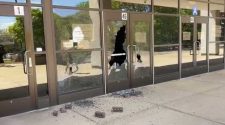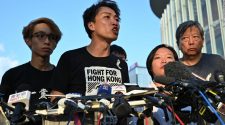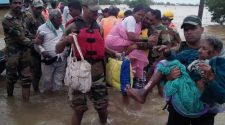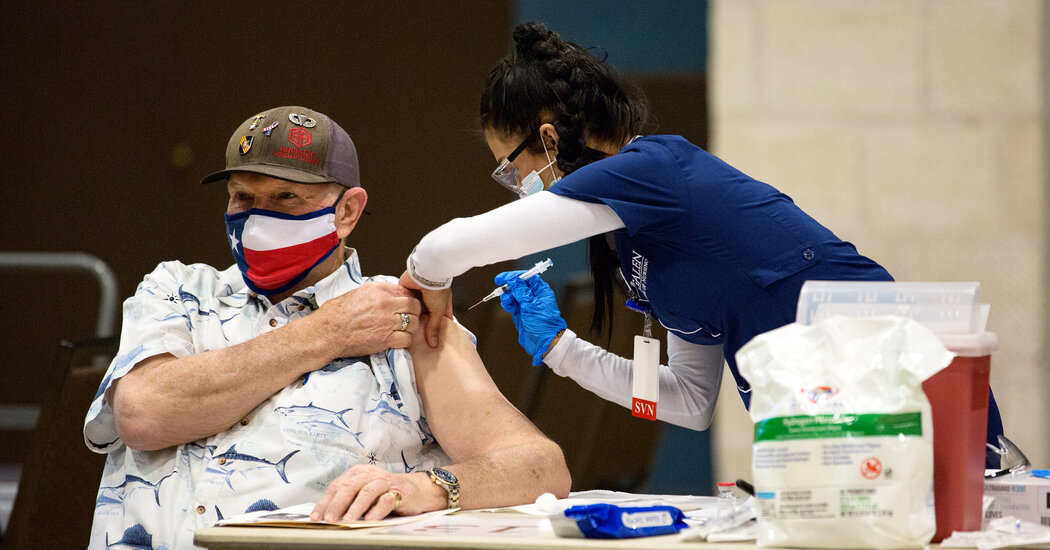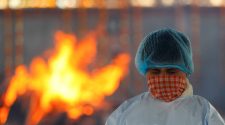Here’s what you need to know:

President Biden, by predicting on Friday that the coronavirus-related U.S. death toll would eventually be well over 600,000, could in the end be right.
Or, like others who have tried to forecast the figure, he could be wrong.
Back in March, when Dr. Anthony S. Fauci,the U.S. government’s top infectious disease specialist, said that the pandemic could kill 100,000 to 240,000 people in the country, some thought his projection was too grim to be possible.
On Tuesday, the country surpassed 400,000 deaths. And on Thursday, Mr. Biden predicted — on his first full day on the job — that the death toll would top 500,000 next month, an estimate supported by models from public health experts.
“The virus is surging. We’re 400,000 dead, expected to reach well over 600,000,” Mr. Biden said on Friday evening. “No matter how you look at it, we need to act.”
Meanwhile, an aggregate forecast from the Centers for Disease Control and Prevention comprising various independent models projects that 465,000 to 508,000 deaths could be reported by Feb. 13.
At many points over the past year, even dire death toll projections have fallen short of reality. The U.S. failed to bring the virus under control when it had a chance to do so in the spring. New, more transmissible variants now make the outlook for the virus harder to predict.
Two days after reaching 400,000 deaths, according to data compiled by The New York Times, the country had already passed 410,000. The U.S. added more than 4,100 deaths on Thursday, the third-highest daily total of the pandemic. About 120,000 people are hospitalized with the virus, and the country is adding about 1.3 million new cases a week.
From the start, the Trump administration was loath to acknowledge the carnage from the virus. Last April, Dr. Deborah L. Birx, the former administration’s coronavirus response coordinator, said that aggressive social distancing measures had appeared to slow the spread and suggested the number of dead might be lower than initially feared — perhaps about 60,000.
That figure was reached within weeks. In May, President Donald J. Trump adjusted that projection to between 75,000 and 100,000 deaths. (He then claimed success would be anything less than 2.2 million fatalities, the most extreme prediction if the country had done nothing at all to respond to the pandemic.)
The death total reached 100,000 by May 27 and 200,000 on Sept. 22. On Dec. 14, it hit 300,000, an accelerating pace that continued to speed up, resulting in a mere five weeks between that milestone and the death toll of 400,000.

As the coronavirus tears across much of Texas, Dr. Esmaeil Porsa is grappling with one of the most formidable challenges he has faced: The Houston hospital system he operates is running out of vaccines.
Dr. Porsa, the chief executive of Harris Health System, which treats thousands of mostly uninsured patients, warned on Friday that its entire vaccine supply could be depleted by midday Saturday. The problem is not one of capability — the vaccination centers that Dr. Porsa oversees have easily been administering as many as 2,000 vaccines a day — but of availability.
“All of a sudden, the distribution of vaccines stopped,” Dr. Porsa said. “It’s perplexing and frustrating because I keep hearing that there are high percentages of vaccines that have been distributed but not administered.”
In the midst of one of the deadliest phases of the pandemic in the United States, health officials in Texas and across the country are growing desperate, unable to get clear answers as to why the long-anticipated vaccines are suddenly in short supply. Inoculation sites are canceling thousands of appointments in one state after another as the nation’s vaccines roll out through a bewildering patchwork of distribution networks, with local officials uncertain about the supplies they will have in hand.
In South Carolina, one hospital in the city of Beaufort had to cancel 6,000 vaccine appointments after it received only 450 of the doses it had expected. In Hawaii, a Maui hospital canceled 5,000 first-dose appointments and placed 15,000 additional requests for appointments on hold.
The situation is especially dire in Texas, which is averaging about 20,000 new coronavirus cases a day, fueling concerns over whether officials will be able to curb the spread when they cannot get their hands on the vaccines that they desperately need to do so.

Even as New York City officials focus on vaccinating millions of residents, the coronavirus continues to spread, with more than 50 ZIP codes showing a positive test rate over 10 percent.
Each day recently has typically seen about 5,000 new cases of the virus and has recorded more than 60 new deaths. While the numbers of deaths and hospitalizations are nowhere near what they were during the city’s peak of the epidemic in the spring, public health experts wonder how much worse the data needs to get before officials consider new steps and restrictions.
“I feel like people are numbed by the numbers; I worry about the complacency and fatigue,” said Dr. Wafaa El-Sadr, an epidemiologist at Columbia University’s Mailman School of Public Health. “I worry about the focus on vaccines, rather than what’s happening with the virus.”
The 54 ZIP codes in New York City with seven-day average positivity rates of over 10 percent span every borough, city statistics showed on Friday. Two more ZIP codes were at 10 percent. Bronx, Queens and Staten Island have positive test rates higher than 9 percent.
Not long ago, Gov. Andrew M. Cuomo pledged to largely lock down areas where positive test rates consistently topped 4 percent. But as rates rose above that statewide, those plans were scrapped.
Currently the sole measure presented by Mr. Cuomo to trigger a lockdown is a complicated projection regarding hospital capacity. Officials say they are not considering any adjustments to that model.
In the ZIP code that includes Brighton Beach in southern Brooklyn, more than 500 cases were reported from Jan. 13 to 19. In all, more than 36,000 city residents tested positive during that period; nearly 2,500 people with Covid-19 were admitted to hospitals.
Transmission in the city has become so widespread that Dr. Tom Frieden, a former director of the Centers for Disease Control and Prevention, recommended that all New Yorkers change their behavior.
“People in New York City should leave home only for outdoors or essential indoors activities given the level of spread in the community,” he said Thursday.
The need to better control brisk transmission is especially essential now that a more contagious variant of the virus from Britain has been detected in the city, Dr. Frieden and other epidemiologists said.
At the current rate of vaccination, experts say, it will take months to change the virus’s trajectory.

The numbers seemed incomprehensible.
Eleven million residents in Wuhan, China, woke up to learn that they had been indefinitely confined to their homes. More than 30,000 travelers found themselves instantly stranded. And a “mystery virus,” had spread seemingly overnight to at least three countries, killed 17 people and sickened more than 570.
It was the morning of Jan 23, 2020.
Wuhan, the first city to be devastated by the coronavirus, was set to be locked down at 11 a.m. Anyone with the means to leave was doing so. But Chris Buckley, The Times’s chief China correspondent, boarded a train in Beijing and headed into the hot zone.
In a matter-of-fact text message sent to his editors in Hong Kong at 9:35 a.m., he wrote, “I’m on the G79 high-speed train that should get into Wuhan at about 2.”
Simultaneously, The Times had published a live briefing, a dynamic digital article intended to cover the rapidly unfolding story.
In a dispatch to the briefing posted at 11 a.m., Chris wrote that a passenger aboard the train warned him that the authorities “probably won’t let people out” of the city until after the Lunar New Year holiday.
Had she been right, Chris would have been home in four days. Instead, it would be four months before he was able to leave Wuhan, when the lockdown was ultimately lifted.
Within 12 hours of publishing the first version of that briefing, two more Chinese cities, with a combined population of 8 million, went into lockdown, six more deaths were confirmed and the number of known cases jumped by more than 200.
In the 12 months since, this briefing has run unabated. Staffed by editors and reporters around the world, it has borne witness to an unceasing global tragedy.
On this, the first anniversary of the Wuhan lockdown, our staff looks back at the toll the virus took on that city, and interviews individuals who found courage in adversity, calm amid grief, and meaning in chaos.
The briefing goes on: 365 days, 96 million cases, 2 million deaths, 222 countries and territories, 3.9 billion people asked to stay home.
And still the numbers stagger.

Larry King, who shot the breeze with presidents and psychics, movie stars and malefactors in a half-century on radio and television, including 25 years as the host of CNN’s globally popular “Larry King Live,” died on Saturday in Los Angeles. He was 87.
Ora Media, which Mr. King co-founded in 2012, confirmed the death in a statement posted on Mr. King’s own Twitter account and said he had died at Cedars-Sinai Medical Center.
The statement did not specify a cause of death, but Mr. King had recently been treated for Covid-19. In 2019, he was hospitalized for chest pains and said he had also had a stroke.
A son of European immigrants who grew up in Brooklyn, N.Y., and never went to college, Mr. King began as a local radio interviewer and sportscaster in Florida in the 1950s and ’60s, rose to prominence with an all-night coast-to-coast radio call-in show starting in 1978, and anchored CNN’s highest-rated, longest-running program from 1985 to 2010, reaching millions across America and around the world.
With the folksy personality of a Bensonhurst schmoozer, Mr. King interviewed an estimated 50,000 people of every imaginable persuasion and claim to fame — every president since Richard M. Nixon, world leaders, royalty, religious and business figures, crime and disaster victims, pundits, swindlers, “experts” on U.F.O.s and paranormal phenomena, and untold hosts of idiosyncratic and insomniac telephone callers.
Mr. King might have made a fascinating guest on his own show: the delivery boy who became one of America’s most famous TV and radio personalities, a newspaper columnist, the author of numerous books and a performer in dozens of movies and television shows, mostly as himself.
His personal life was the stuff of supermarket tabloids — married eight times to seven women; a chronic gambler who declared bankruptcy twice; arrested on a fraud charge that derailed his career for years; and a bundle of contradictions who never quite got over his own success but gushed, star-struck, over other celebrities, exclaiming, “Great!” “Terrific!” “Gee whiz!”
He made no claim to being a journalist, although his show sometimes made news, as when Ross Perot announced his presidential candidacy there in 1992. And he was not confrontational; he rarely asked anyone, let alone a politician or policy maker, a tough or technical question, preferring gentle prods to get guests to say interesting things about themselves.

New infections in recent months and a contagious new variant threatening to accelerate the pandemic have prompted some governments to revert to their harshest social-distancing measures.
In Hong Kong, the authorities said on Saturday that they had locked down part of a densely packed neighborhood and started to test everyone there, one of the most drastic measures that the Chinese territory has taken since the coronavirus surfaced there last winter.
The local government said on Saturday that it had restricted access to some parts of the Jordan District, one of Hong Kong’s most crowded, and that people there would be prevented from leaving until they had been tested, the first such lockdown in the territory. Battalions of police officers were seen guarding the area’s perimeter as health workers in head-to-toe protective gear walked inside.
About 200 buildings in the Jordan area were affected, and more than 1,700 police and other officers were expected to be deployed, The South China Morning Post reported.
Officials said that 162 confirmed coronavirus cases had been recorded across 56 buildings in Jordan in the first 20 days of January.
The government plans to finish testing residents in the restricted area within 48 hours, in time for residents to go to work on Monday morning.
As of Saturday, Hong Kong was averaging 73 daily cases over the past week, according to a New York Times database.
In Madrid, restaurants and bars will need to close early on Monday, as part of a series of new lockdown restrictions announced by the authorities in Spain’s capital region.
The new rules comes only days after Isabel Ayuso, the leader of the Madrid region, pledged instead to avoid any further clampdown on restaurants, saying that “if you want to ruin hostelry, don’t count on me.”
Instead, restaurants will need to close at 9 p.m. — effectively stopping them from serving at traditional Spanish dinner hours — and also limit the number of people sharing a table to four, rather than six. Madrid’s nighttime curfew will also be moved forward to 10 p.m. from 11 p.m.
Madrid is joining other regions of Spain that have been tightening their lockdown since the start of the year, amid particular concerns about the spread of a new variant of Covid-19 first detected in Britain.
But the central government has so far resisted calls from some regional politicians to return the country to a full lockdown, like that enforced in March when the coronavirus first inundated Spain. The average daily number of registered Covid-19 cases in Spain has doubled over the past two weeks, reaching past 35,000 on Friday.

Pfizer, after discovering it could squeeze an extra vaccine dose out of vials that were supposed to contain only five, plans to count the surprise sixth dose toward its previous commitment of 200 million doses of Covid vaccine by the end of July. That means it will be providing fewer vials than once expected for the United States.
And yet, pharmacists at some vaccination sites say they are still struggling to reliably extract the extra doses, which require the use of a specialty syringe.
For weeks, Pfizer executives pushed officials at the Food and Drug Administration to change the wording of the vaccine’s so-called emergency use authorization so that it formally acknowledged that the vials contained six doses, not five.
The distinction was critical: Pfizer’s contract with the federal government requires that it be paid by the dose.
At one point, Pfizer executives lashed out at the top federal vaccine regulator over the government’s reluctance to budge on the request, according to people familiar with the discussions who were not authorized to discuss them.
On Jan. 6, Pfizer got what it wanted. The F.D.A. changed the language in its fact sheet for doctors to confirm that the vials contain a sixth dose. The change mirrors similar labeling updates by the World Health Organization and the F.D.A.’s counterpart in the European Union.
Company officials, including the chief executive, Dr. Albert Bourla, have said that the sixth dose allows Pfizer to stretch its supply of scarce vaccine even further — it was one factor, for example, in the company’s new estimates that it will be able to manufacture two billion doses for the world this year, instead of the 1.3 billion it had originally planned.
The U.S. negotiations come at a particularly harrowing time, as the Biden administration is said to be discussing the purchase of a third round of 100 million doses of Pfizer’s vaccine later in the year. The country is racing to vaccinate as many people as possible before more contagious virus variants become widespread, potentially spurring a wave of new hospitalizations and deaths.



